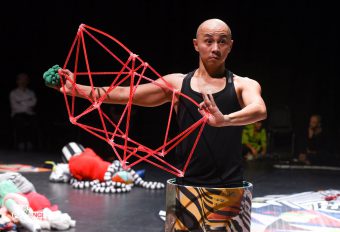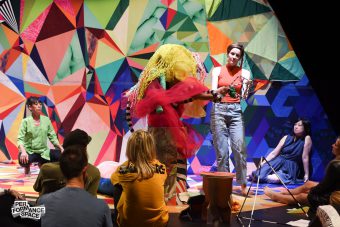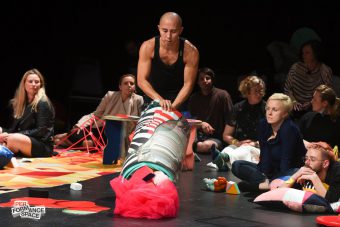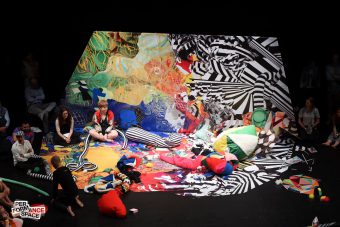
Stepping into the fantasy of Daniel Kok and Miho Shimizu’s xhe beholds an immediate amplification of the senses. Their world borders between the vicissitudes of childlike fragility and maximal emotion, one where you can’t – even for a second – look away. Its psychedelic surfaces thrive with toys and objects ordinarily found in a kindergarten, suddenly made strange in its divorce from such context. Geometric cardboard cut outs, stick pyramids, plushie toys, foam wedges, and blankets fashioned into avant-garde dress splay in wild colours across the stage, a space enclosed by two walls patterned in similar frenzy. As audience members, we are invited to walk through the mix, to touch and play with the items laid out if the desire strikes, or otherwise, free to sit in the sidelines to observe the action unfolding.
At a certain point during xhe’s debut performance at Performance Space’s Liveworks Festival, Kok whips a plushie toy lasso above his head while standing on a cubed altar composed of foam mats. We stare subject to his defiance; he pulls into slow rotation while his fingers point in protracted pause. One… two… three… a dancer turned military commander turned showgirl. It’s only after the ninth, perhaps tenth swath around the podium (too mesmerised to specify), that Kok steps down, turns inwards to a curl on the floor. The improvised score (Filastine & Nova) thickens to crescendo, an assemblage of concrete sound, synth and strings elevating Kok’s repetitions to ritualistic effect.

There are numerous moments like these throughout the five-hour durational performance, heightened passages where movement, objects and sound coalesce into a horizon of intensifying possibility. Other times, the movement could be considered completely ordinary – even inconsequential or of nothing – although never becoming drab. More than once, dancer Karol Tyminski strides deliberately across the floor, picks up a long cylindrical multi-coloured plushie and strikes it against the wall, again and again. We see simultaneously the banality and incredulity of his actions unfold in marriage. Actions that would otherwise be utterly decontextualised in their meaning find a space to be interpreted between two polar ends.
In the artist statement, Kok says xhe concerns itself with “audienceship as a political question.” He emphasises audienceship as opposed to spectatorship. Instead of the universalist ‘sitting-there’ passivity engendered in performance as spectacle, Kok attempts to activate performance as a site which mirrors the pluralistic conditions of the audience experience in contrast to the singular subject. This sentiment resonates with me the second time I see xhe – a Sunday afternoon where the audience is enlivened with toddlers, parents, whole families. An atmosphere of play pervades. On the stage, kids shuffle through toys in the unreserved way only children possess. This is an audience that does not care for paralysis or uncertainty when it comes to participation. The air too, is much looser, compared to xhe’s first performance, which was weighed with an expectancy typical of opening nights.

I see a boy centrestage wrapped in hug by a foam cylinder, bare feet poking out the ends like the haphazard sides of a gummy wrapper. He remains in that same position for the hour I stay, absorbing into the materiality of the performance as much as the structures already in place. Was the boy always there? Did he arrive here knowing that he would be choreographed into this live situation? On a base level, we know already the answer to these questions. But the imprints of such mysteries deepens the excitement of the work, throwing into possibility a multiplicity of conclusions. Borders collapse; beginnings, middles and ends are drawn, then redrawn, line after line more blurred.

xhe never retreats into passivity. The performance proclaims improvisation as a springboard to stretch the limitations of imagination (of both the performer and audience.) By imagination, I mean the strategies used to continually morph, transform, hybridise and reimagine what dance can and should be. In its five-hour span, xhe revealed itself as a momentary utopia where both performers and audience members decide into ongoing project with one another, a shared future of becoming.

I recall a moment on the second afternoon, when Tyminski approaches the coloured wall and eases into several breaths, leaning his cheek upon the barricade in an exaggerated, earnest sort of intimacy. He turns and says to us in half-bemusement: here is the wall, touch it, don’t be shy. There is a beat before we arise. First, a trickle, which kickstarts a collective action for everyone to walk towards him. We stream our cheeks against the wall, tender mining the distance.

